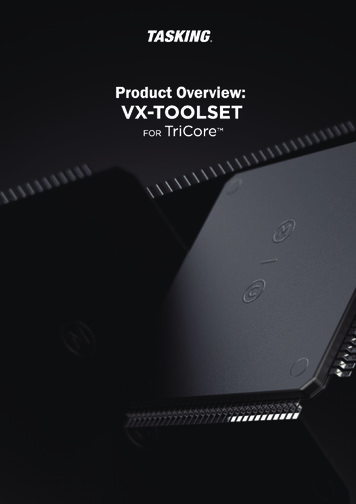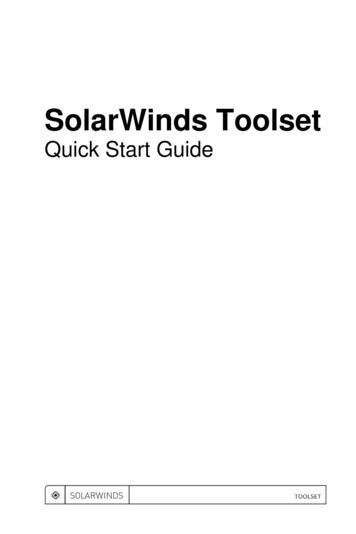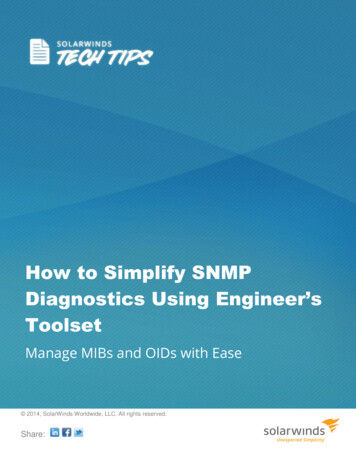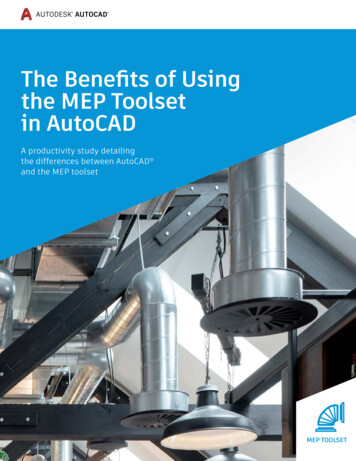
Transcription
PRODUCT OVERVIEW: VX-TOOLSET FOR TriCoreA COMPLETE DEVELOPMENT SOLUTIONThe Altium TASKING VX-toolset for TriCore (Release v6.2) is a complete solution for code development forAURIX multi-core hardware from Infineon . The VX-toolset produces fast and compact code, not just for theTriCore, but the other cores within AURIX, including the GTM, SCR, HSM, and SCR. This best-in-class compilerperformance coupled with a decades-long industry track record at both large and small enterprises, plus ASPICELevel 2 certification provide the assurance you need for your development projects.Here is a summary of TASKING VX-toolset for TriCore features. More detailed discussions of these features followthis introduction. Great performance for both manually written and model based/auto codingMulti-core optimization with universal linker support for all cores plus language extensionsProfiling and debugging (both hardware and software)Safety- Safety Kit- MISRA- Built in Safety Checker- ASPICE Level 2 certifiedPremium support for current and old versions availableEasy to get started and begin benchmarking with pin configuratorVery broad support for MCAL and industry standard RTOSsCompatible with relevant third party timing analysis toolsEASY TO DEPLOY, EASY TO USEThe Altium TASKING VX-toolset uses the industry’s favorite Eclipse integrated development environment (IDE)that allows users to instantly begin working in a familiar environment. Eclipse ties all the tools together and makestheir full power accessible with ease. Eclipse also makes it easy to integrate the VX-toolset into custom-builtsystems.For customers who already use TASKING compilers, cross-linking allows you to safely mix old and current compilerversions. For example, you can use MCAL with a previous compiler to take advantage of capabilities and codealready written.Whitepapers, webinars, and forums provide further education and learning opportunities to ensure effective andefficient use of TASKING tools.PICK THE BUNDLE TO MATCH YOUR NEEDSYou can choose the best fit for your application development activities from four bundles: Standard, Professional,Premium and Enterprise Editions. Along with the standard Eclipse, C/C compiler toolset and simulator modules,additional functionality includes options such as C compilers for the HSM, GTM, SCR and PCP cores, on-hardwaredebugging through an OCDS solution and a USB-to-JTAG wiggler.
PRODUCT OVERVIEW: VX-TOOLSET FOR TriCoreMULTI-CORE SUPPORTThe VX-toolset provides two advanced methods for multi-core program development for the AURIXmicrocontroller, which includes: Compile time core association: Crosscore access is detected by the compiler in an early stage. This allowsfor the best control of code and data destination on the various cores. Stricter coding discipline is asked fromthe developer, resulting in better quality control while delivering optimal program execution.Link time core association: The destination core is selected in the final step, delivering ultimateprogramming flexibility and allowing for straightforward reusability of existing code.For ultimate flexibility and program execution, both methods can be used together.The linker also supports references between TriCore core memories and GTM/MCS memories, and betweenTriCore core memories and SCR memory. The GTM/MCS memories (RAM) and the SCR memory (RAM) can beinitialized automatically by the TriCore start-up code from the TASKING run-time library.CROSS-LINKINGCross-linking allows linking of object code built with an earlier toolset release into a project that is being developedwith a more recent toolset release. With releases v6.1r1 and v6.2r1 of the toolset, Altium guarantees compatibilityof code developed with versions v4.2r2 and v5.0r2 of the product, under specific conditions.Through this guarantee the user can re-use application code or use third party code developed and validated withan older compiler release. This will give the user more flexibility and more products to choose from, like MCALlibraries, Real-Time Operating Systems and communication stacks from parties like Infineon Technologies, ETAS,Elektrobit, and Vector.C COMPILERSUsing the latest compiler technologies from Altium, all VX-toolset C compilers are reliable, compliant, best-in-class,complete, compatible and easy to use to generate the most optimal code. The TASKING VX-compilers are testedfor ISO C’99 and ISO C conformity against authoritative validation suites, such as Perennial and Plum Hall . Inaddition, the optimization techniques of the compilers are tested with large real-world applications (for example,powertrain and body control sources), as well as industry benchmark standards such as Nullstone and EEMBC.
PRODUCT OVERVIEW: VX-TOOLSET FOR TriCoreTRICORE C COMPILERThe VX-toolset Includes a C compilerfor TriCore core programming. Thecompiler supports all languageextensions up to the C 11 standard.Full C 11 libraries are provided aswell.With Viper compiler technology,the TASKING VX-toolset for TriCoregenerates code with the smallestfootprint and fastest execution.Depending on the specificrequirements of your TriCoreapplication, optimizations can befurther tweaked for smaller code sizesor higher execution speeds.Compiler optimizations include: Partial Redundancy Elimination(PRE) detects and eliminatesrepeating (sub-) expressions.Figure 1: The compiler is easy to set up and use for the entire TriCore family. Various Loop and Jumpoptimizations speed up executionand reduce code size. Control-flow and code-reduction optimizations remove dead code and perform transformations to minimizejumps. Function inlining replaces calls to small functions with inlined copies of the function code. Peephole optimizations replace instruction sequences with equivalent but faster and/or shorter sequences, orremove obsolete instructions. Inter-procedural register allocation Application wide code compaction (also called reverse inlining) Application wide speed optimizations by “MIL linking”Syntax and Semantic ChecksThe compiler offers a vast array of syntax and semantic checks that warn about potential undesirable effects orbugs in your program. Early fixing of source code problems when reported by the compiler generally only takesminutes compared to hours, or days, when the problem is discovered at run time.Examples of compile-time checks include: Validating printf and scanf format strings against the type of the actual arguments Detection of reads from uninitialized memory locations Detecting unused variables “Value tracking”, which is used to detect errors such as:– Array subscript out of bounds– Constant conditions
PRODUCT OVERVIEW: VX-TOOLSET FOR TriCoreRuntime Error CheckingThe runtime error checking capabilities in the compiler can reveal runtime errors when they first occur. Thekind of errors found by runtime error checking are typically hard to find since they manifest themselves throughsecondary effects or, in the worst case, will not manifest at all prior to your product being shipped. By identifyingthe source line where the error first occurs, the runtime error checking facilities reduce the time spent in thedebugger and increase the quality of your software. You can specify whether the application will terminate orcontinue when an error is detected.These optional checks are implemented by generating additional code and/or enabling additional code in thestandard C library. Runtime error checking has a nominal effect on code size and execution speed and can beenabled on a module-by-module basis, making it practical for use in debugging large applications.The following types of checks are provided: Bounds checking verify all pointer operations to detect buffer overflows and other illegal operations including:– Accessing uninitialized or null pointers– Accessing objects outside their declared bounds– Illegal pointer arithmetic Malloc / free checks uncover dynamic memory allocation errors including:– Write to freed memory– Multiple calls to free– Passing an invalid pointer to free Report an unhandled case value in a switch without a default part.CPU Functional Problem SupportSemiconductor vendors regularly publish microcontroller errata sheets reporting deviations from the electricaland timing specifications. As an integral part of best practice architecture support, the TASKING VX-toolset forTriCore provides bypasses and checks for identified silicon defects. CPU functional problem support is providedthroughout the complete toolset, including: C-compiler bypasses adapt code generation in order to avoid the identified erratic instruction sequences.Assembler checks warn the assembly programmer for suspicious or erroneous instruction sequences.Protected C-library sets are built with bypasses for all identified CPU functional problems.If reliability of your embedded application is essential, be sure to put support for CPU functional problems on yourlist of compiler selection criteria. Through its close partnership with semiconductor vendors, Altium offers themost comprehensive support for this with its TASKING compilers.Static Code AnalysisStatic code analysis is a method used to verify all possible paths within a software program without actuallyexecuting the program. A static code analysis tool can efficiently locate defects including out of bound array access,memory allocation errors, arithmetic over and underflows, and inconsistent code fragments that go unnoticedduring dynamic tests or peer reviews. Static code analysis can be applied early in the software developmentprocess, and can be applied on incomplete and incorrect code bases and when no test-cases need to bedeveloped.Altium has integrated static code analysis functionality for CERT C and MISRA C in its C compilers, with theadvantage that such an analyzer is aware about specific embedded software issues such as:The existence of special function registers, the use of inline assembly languageC-language extensions such as pointer and memory space qualifiers to address multiple address spacesDSP specific data types such as circular buffers, and fixed point data types.
PRODUCT OVERVIEW: VX-TOOLSET FOR TriCoreIntrinsicsCertain assembly instructions have no equivalence in C. Intrinsic functions let you benefit from inclusion of thoseassembly instructions in your application. Intrinsic functions are predefined functions for which the compilergenerates highly efficient assembly code. The compiler supports a wealth of intrinsic functions, includingdedicated functions for AURIX 2nd Generation, enabling you to get the maximum efficiency out of the MCU.The compiler always inlines the corresponding assembly instructions in the assembly source. Although it ispossible to inline assembly code by hand, intrinsic functions use registers more efficiently and their use preventsyour C source code from becoming less readable.C Compiler for GTMThe TASKING TriCore toolset includes a fully integrated C compiler that supports the third generation GenericTimer Module core from Bosch which is present on the Second Generation AURIX. Programming a complex corelike the GTM in C makes you more productive both in the development phase as well as the maintenance stage.In addition to an optimized programming approach with the TASKING TriCore compiler, the GTM C compiler alsosupports the “C array” output format, enabling interoperability with third party toolsets. If you develop an AURIX2G application with the C compilers for the TriCore and GTM from the VX-toolset for TriCore, you can re-use yourGTM application code in an RH850 or Power Architecture based project with a C compiler for such MCU fromanother vendor. (The GTM compiler is also available as a separate TASKING product.)The first GTM core generation present on the AURIX variants is fully supported by means of the included MCS/GTM assembler.C Compiler for HSMFor programming the Hardware Security Module of the AURIX microcontrollers, the TASKING VX-toolset includes afully integrated and dedicated C/C compiler. This compiler is based on the standard C compiler for the Cortex-Mseries from Altium, and it can easily be accessed from the TriCore tool set’s IDE.C Compiler for SCRAll Second Generation AURIX devices as well as select AURIX derivatives, such as the TC26x series, have adedicated 8-bit Standby Controller (SCR) on board. This controller is based on the Infineon XC800 microcontrollerand Altium has developed a new and highly optimizing C compiler to program this core with its limited memoryspace. This exclusive compiler based on VX technology from Altium, generates more efficient code than traditionalXC800 compilers and is therefore the ultimate programming tool to deal with the limited resources of the StandbyController. It is fully integrated in the VX-toolset for TriCore and does not require a third-party compiler solution.C Compiler for PCPAltium offers a unique C compiler for the TriCore Peripheral Control Processor (PCP). Despite the limitedfunctionality and restricted instruction set of the PCP, we have been able to develop a fully functional C compiler.The C compiler delivers code at an unexpectedly high performance level and provides several special extensionsfor PCP programming.
PRODUCT OVERVIEW: VX-TOOLSET FOR TriCoreINTEGRATED SAFETY CHECKERThe latest release of the VX-toolset for TriCore has been enhanced with integrated Safety Checker functionality,which helps the developer to prevent interference between software elements with incompatible ASIL levelsin an application. Unlike traditional static analysis tools that check for dangerous code constructs against thespecification, the Safety Checker operates closely to the hardware while still able to check high-level safetyrequirements. This makes it an ideal companion, bridging the gap between ISO 26262 requirements andtraditional software tests.The Safety Checker helps to find MPU traps that are very difficult to cover with testing. The Safety Checker allowsyou to assign linker sections to safety classes you define, even for existing object files where the source code isn’tavailable. Access between different safety classes and violations will be shown immediately. Based on the actualresult of locating sections and their safety class assignments, the linker can generate a table of memory rangesand access restrictions which can be used by the application at run-time to configure the MPU of an AURIX device.CERT CThe CERT C/C secure coding standard is defined by the Computer Emergency Readiness Team (CERT), foundedby the US government. Altium is one of the first vendors to provide a CERT C coding guidelines analyzer builtinto a C compiler for embedded software development.MISRA CMISRA C is driven by the Motor Industry Software Reliability Association and guides programmers in writing morerobust C-code by defining selectable C-usage restriction rules. Through a system of strict error checking, the useof error-prone C-constructs can be prevented. The TASKING C compiler offers the industry’s first support forMISRA-C:1998, MISRA-C:2004 and the latest MISRA-C:2012 guidelines, including Amendment 1: Additional securityguidelines for MISRA C:2012, dated April 2016.INTEGRATED DEBUGGERThe integrated debugger has beenredesigned from the ground up and isready for trends like integrated kernelawareness and multi-core debugging.Utilizing the Eclipse IDE workbench,it comes as a plug-in with a seamlessintegration to the editing environment.With the VX-toolset for TriCore it providestwo execution environments servingvarious debugging needs.Debugging Via Infineon DAS SupportMaking the most of the On-Chip-DebugSupport (OCDS) facilities built into theInfineon TriCore microcontrollers, ourdebugger offers an accessible, high qualityin-circuit-emulation functionality. TheVX-toolset has been tested and qualifiedwith the Infineon Debug Access Server(DAS) solution. The DAS environment isthe universal emulation access softwareFigure 2: Configuring the debugger is simple, with mostselections menu based.
PRODUCT OVERVIEW: VX-TOOLSET FOR TriCorearchitecture for all Infineon microcontroller families. Extensive support for DAS is guaranteed by Infineon and, as aresult, Altium has adopted this debug standard.Through DAS, the TASKING TriCore debugger is compatible with Infineon TriBoard Starter Kits and Application Kitswith an on-board wiggler through USB cable. This debugger is also compatible with the Infineon DAS miniWigglerdebug probe, enabling a very cost-effective debug solution for on-hardware testing for custom hardware or otherevaluation boards.Figure 3: The debugger offers an easy-to-use environment.TriCore Instruction Set Simulator DebuggingThe TriCore simulator debugger features instruction set simulation, allowing you to extensively debug andregression test your application on your PC, even before your target hardware is available. A plug-in for instructionset simulation of the PCP is also included.Code ProfilingIn addition to the profiling features built into the debugger, the compiler also has a profiler that uses code instru–mentation. Code profiling can be used to determine which pieces of your code execute slower than expected andwhich functions contribute to the overall execution time of a program. A profile can also tell you which functionsare called more or less often than expected. The advantage of this code profiling option in the compiler is that itcan give a complete call graph of the application annotated with the time spent in each function and basic block.
PRODUCT OVERVIEW: VX-TOOLSET FOR TriCoreAURIX CONFIGURATION TOOLSAdvanced microcontrollers are equipped with a large number of on-chip peripheral modules, but the limitednumber of pins on the chip usually does not allow all modules to be used simultaneously. The TASKING PinMapper functionality removes the developer’s complex challenge of configuring chip hardware registers that areused for assigning the peripheral module signals to the physical pins. The Pin Mapper provides an interactivevisual representation of the pin layout within the toolset IDE, through which the developer can configure andreview properties of the pins.The Pin Mapper reports errors or warnings for possible connection conflicts, saving the developer from thetedious task of maintaining an overview of the pin assignments in spreadsheets. You can solve pin conflicts byhand by making other connections, but when there are many conflicts or in situations where most port pins arein use, it can be quite cumbersome and complex to solve conflicts. The Pin Conflicts Solver can automate thisprocess and will solve most conflicts for you.Through the graphical editor and code generator from the TASKING Software Platform, you can quickly configure(Infineon iLLD) low-level drivers, various C files and header files, as well as the RTOS for use in final productapplications. This significantly simplifies the required steps to program an advanced microcontroller.ECLIPSE IDEThe IDE, built on the Eclipse framework, provides a seamless workbench for the complete tool chain includingthe debugger of the VX-toolset. The IDE provides facilities for project configuration and management, C/C andassembly code-aware editing, build management, debugging, profiling and more. It provides functionality to helpyou set up your embedded TriCore project and configure your target board settings to debug your project onhardware.The Eclipse editor supports C, C , assembly language and header files with syntax highlighting, auto completion,context assistance and tool tips. As you would expect from a de facto standard IDE, it provides full supportfor all relevant source code version control systems. The Eclipse environment provides a single platform formany different embedded-product toolsets from different vendors. The standardization on an industry-wideIDE significantly reduces your learning curve, removes the barriers of changing development tools for differentarchitectures, increases your productivity, and ultimately reduces the time to market with your end product. Theavailability of plug-in modules to enhance or extend the feature set of the Eclipse IDE ensures that you can buildthe workbench according to your development needs. With the concept of the open Eclipse framework, thirdparty tool vendors can now develop plugins that tightly integrate into various IDEs from different vendors, unlikeproprietary IDEs where custom connectivity needs to be created.The IDE in the VX toolset is based on the Mars release of Eclipse and the C/C Development Tools (CDT). Altiumhas built the integration blocks for the toolset and extensions to Eclipse to make the whole environment acoherent workbench. Plus, with the Eclipse IDE, it is easy to integrate into third party, custom built systems.
PRODUCT OVERVIEW: VX-TOOLSET FOR TriCoreFigure 4: The TASKING VX toolset uses the de facto standard Eclipse IDE, making an easy learning curve.AUTOMOTIVE SPICE CAPABILITY LEVEL 2 (ASPICE CL2)The TASKING VX-toolset for TriCore/AURIX is developed using an ASPICE CL2 process. Automotive SPICE is aframework for designing and assessing software development processes. Effective implementations lead to betterprocesses and better product quality. It was developed by the consensus of several major car manufacturers.Automotive SPICE has become a standard in the international automotive industry.
PRODUCT OVERVIEW: VX-TOOLSET FOR TriCoreWHICH BUNDLE IS THE BEST FOR YOU?The TASKING VX-toolset from Altium isavailable in targeted bundles – Standard,Professional, Premium and EnterpriseEditions, allowing you to choose the best fitfor your application development activities.Target architecture supportThe TASKING VX-toolset supports all TriCore derivatives. Fromwithin the Eclipse IDE you can easily select the TriCore deviceof your choice for your project:TMTMThe Enterprise Edition is the best choice ifAURIX 2G devices: TC39x; AURIX devices: TC21x, TC22x,you want to have all essential developmentTC23x, TC23x ADAS, TC26x, TC27x, TC29x; TriCore devices:tools around the C/C compiler integratedTC1130, TC1166, TC1167, TC1184, TC1197, TC1337, TC1367,into one environment. In addition to aTC1387, TC1736, TC1746 [TC1782bd], TC1724, TC1728, TC1748software simulator, it offers an on-hardware[TC1798bd], TC1762, TC1764, TC1766, TC1767, TC1768debugging solution – using anOCDS solution[TC1387bd], TC1782, TC1791, TC1792, TC1793, TC1796, TC1798with a USB-to-JTAG wiggler. The OCDSdebugger is the most cost-effective onAltium’s active relationship with Infineon Technologieshardware debug solution you can get. Theenables us to support new derivatives already in the toolsettruly unique parts of the Enterprise Editionprior to their availability in volume.are the C compilers for the HW SecurityModule (HSM), the GTM, the SCR and thePCP, as well as the Code Safety Checker forASIL. If you plan to write your code for the additional cores in C language, this Enterprise Edition is the best andonly option on the market.The Premium Edition is nearly as comprehensive, with the exception of the GTM compiler and the integrated CodeSafety Checker.The Professional Edition provides many features of the Premium Edition, including the OCDS debugger and HSM Ccompiler, but without the SCR and PCP C compilers. If you develop your application based on an AURIX with HSMco-processor, or a TriCore derivative without the PCP, this Professional Edition is an attractive solution to consider.Also, if you are fine with programming your TriCore with PCP in assembly code instead of C, this package is a goodchoice. If you purchase this bundle, be sure to add the optional USB-to-JTAG miniWiggler in case your hardwareboard comes without an on-board wiggler.The Standard Edition is the perfect bundle for C/C programming and debugging with a simulator. The MCS/GTMunit of the AURIX can be programmed through the included assembler, whereas the linker is fully prepared formulti-core TriCore development. You can upgrade to the one of the other Editions at a later time, offering you allincluded functionality under a unified interface.
TriCore, but the other cores within AURIX, including the GTM, SCR, HSM, and SCR. This best-in-class compiler . Compile time core association: Crosscore access is detected by the compiler in an early stage. This allows for the best control of code and data destination on the various cores. Stricter coding discipline is asked from











